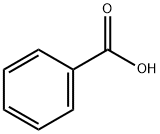Sodium benzoate , Medicinal grade , 532-32-1
Synonym(s):
Benzoic acid sodium salt;BENZOTRON
CAS NO.:532-32-1
Empirical Formula: C7H5NaO2
Molecular Weight: 144.103
MDL number: MFCD00012463
EINECS: 208-534-8
| Pack Size | Price | Stock | Quantity |
| 500G | RMB62.40 | In Stock |
|
| others | Enquire |
PRODUCT Properties
| Melting point: | >300 °C (lit.) |
| Density | 1,44 g/cm3 |
| vapor pressure | 0Pa at 20℃ |
| FEMA | 3025 | SODIUM BENZOATE |
| Flash point: | >100°C |
| storage temp. | room temp |
| solubility | H2O: 1 M at 20 °C, clear, colorless |
| pka | 4.03[at 20 ℃] |
| form | Crystals, Granules, Flakes or Crystalline Powder |
| color | White |
| PH | 7.0-8.5 (25℃, 1M in H2O) |
| Odor | odorless |
| biological source | synthetic |
| Water Solubility | soluble |
| Merck | 14,8582 |
| BRN | 3572467 |
| Stability: | Stable, but may be moisture senstive. Incompatible with strong oxidizing agents, alkalis, mineral acids. |
| InChIKey | WXMKPNITSTVMEF-UHFFFAOYSA-M |
| LogP | 1.88 |
| CAS DataBase Reference | 532-32-1(CAS DataBase Reference) |
| NIST Chemistry Reference | Sodium benzoate(532-32-1) |
| EPA Substance Registry System | Sodium benzoate (532-32-1) |
Description and Uses
Sodium benzoate has the chemical formula NaC7H5O2; it is a widely used food preservative, with E number E211. It is the sodium salt of benzoic acid and exists in this form when dissolved in water. It can be produced by reacting sodium hydroxide with benzoic acid.
Sodium benzoate is a preservative. It is bacteriostatic and fungistatic under acidic conditions. It is most widely used in acidic foods such as salad dressings (vinegar), carbonated drinks (carbonic acid), jams and fruit juices (citric acid), pickles (vinegar), and condiments. It is also used as a preservative in medicines and cosmetics. As a food additive, sodium benzoate has the E number E211.
It is also used in fireworks as a fuel in whistle mix, a powder that emits a whistling noise when compressed into a tube and ignited. The fuel is also one of the fastest burning rocket fuels and provides a lot of thrust and smoke. It does have its downsides: there is a high danger of explosion when the fuel is sharply compressed because of the fuel's sensitivity to impact.
Safety
| Symbol(GHS) |  GHS07 |
| Signal word | Warning |
| Hazard statements | H319 |
| Precautionary statements | P264-P280-P305+P351+P338-P337+P313 |
| Hazard Codes | Xi |
| Risk Statements | 36/37/38-62-63-68-36 |
| Safety Statements | 24/25-36-26 |
| WGK Germany | 1 |
| RTECS | DH6650000 |
| Autoignition Temperature | >500°C |
| TSCA | Yes |
| HS Code | 29163100 |
| Hazardous Substances Data | 532-32-1(Hazardous Substances Data) |
| Toxicity | LD50 orally in rats: 4.07 g/kg (Smyth, Carpenter) |


